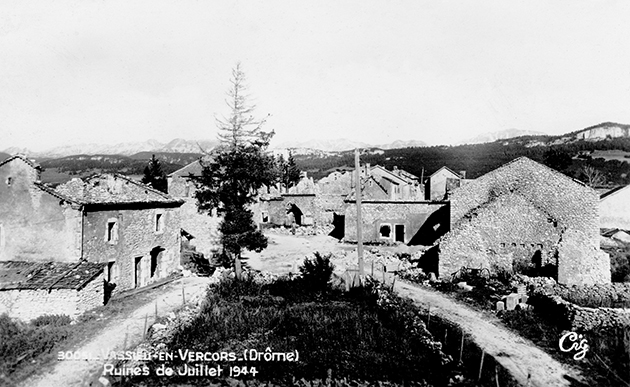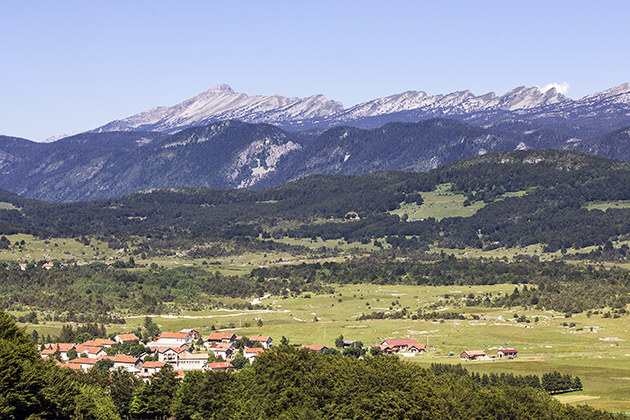Remembering the Resistance: the Vercors maquis

In the collective imagination, the landscapes of the Resistance often make one think of the maquis, hilly or wooded areas where men and women sought refuge in order to organise their resistance against the Vichy authorities and the occupier. The Vercors massif, with its natural landscape, reconstructed villages and commemorative monuments, today preserves the memory of the maquisards of 1943-44.
The attentive observer, visiting the Vercors massif, will first admire the natural beauty of a landscape by turns violent in its rocky ridges and deserts, dark in its forests, and gentle in its valley meadows and mountain pastures.
This variety of terrain made it an ideal combat setting, but at times also turned it into a trap. On closer examination, there are many signs that a major Resistance drama was played out here, many decades ago.

Ruins of Vassieux-en-Vercors, July 1944. © Collection M. Bleicher
First, there are traces of ruins – Herbouilly, Le Revoulat, Valchevrière. In August 1944, after the German troops had left, when hundreds of maquisards and civilians were killed, entire villages and hundreds of buildings were destroyed.
But the signs of reconstruction also attract the eye, with the “nearly new” villages of St-Nizier-du-Moucherotte, La Chapelle-en-Vercors and Vassieux-en-Vercors. Because in Vercors, unlike Oradour-sur-Glane where the ruins were preserved, the choice was made to rebuild, not exact copies, but rural homes with all the modern comforts that were available in the late 1940s. Highways authority chief engineer Albert Piétri and a team of nine architects conducted the whole operation, at once refusing to accept the inevitability of abandonment and determined to offer local people better living conditions than before the war.
The destruction was such that a Vercors Aid and Reconstruction Committee was set up on 1 October 1944. The Ministry for Reconstruction and Urban Planning, Friends of the Vercors Pioneers and local businesses contributed to funding the reconstruction. Swiss aid organisation Don Suisse added to the initial sums allocated for reconstruction, sending medicines, essentials and building materials. By 15 December 1944, work was well underway. In winter 1944-45, 32 temporary huts were put up in the worst-hit communes. Shops and farm buildings were renovated. By November 1945, all the families had been rehoused, at least in temporary accommodation. Flats were built according to precise designs, drawn up in consultation between residents and local authorities. By the summer of 1947, most families had a new home, the crops were recovering and the local economy was reviving. Villard-de-Lans had satisfactory reception facilities and some hotels were willing to accommodate tourists. In autumn 1947, brand-new schools opened to pupils and the birth rate picked up once more.

Vassieux-en-Vercors today. © L. Pascal / La Drôme Tourisme
The Vercors landscape is also marked by a number of significant commemorative structures, some of which were built by the Friends of the Vercors Pioneers: three cemeteries, today owned by the Ministry of the Armed Forces, whose flags flutter in the mountain breeze, literally animating the landscape; a remembrance room; recumbent statues (for example, at Malleval); and a statue by Émile Gilioli. In Vassieux-en-Vercors and at Col de la Chau, a museum and a Resistance memorial evoke Vercors’ Resistance past. Besides these major structures, on roadsides and in forests, clearings, fields or caves, real or imaginary shelters (Pas de l’Aiguille, Grotte de la Luire), Vercors is scattered with steles and small memorials that immortalise the fighting and sacrifice of the maquisards. Over 200 plaques, steles and crosses, like so many flags, dot the landscape of this cradle of liberty.
These sites infuse remembrance today. This constant, visible to and fro between past and present punctuates the daily lives of thousands of inhabitants of the massif and surrounding area, in the names of streets and squares: “Rue des Francs-Tireurs”, “Place des Martyrs”. It is not uncommon to live on “Rue des Pionniers” in Villard-de-Lans, work on “Chemin des Fusillés” in Lans-en-Vercors and send your children to school at the “Cité Scolaire Jean Prévost”, named after the writer and journalist who commanded a company of maquisards in Vercors and was killed by the Germans on 1 August 1944.
In the centre of Vassieux-en-Vercors is a roll of remembrance of the village’s civilian victims, on the “Rondpoint des 5 Communes Compagnons de la Libération”; one of the streets leading to this roundabout is “Avenue des Planeurs”, in memory of the German airborne attack of 21 July 1944. The village is dominated by the rebuilt church, which has a sculpted Cross of Lorraine incorporated into its stonework.
Everything in the Vercors landscape recalls the courage and faith that united resistance members in their struggle for the liberation of France, seven decades ago.

